Study of the Influence of the Excipients Used for the Synthesis of Microspheres Loaded with Quercetin: Their Characterization and Antimicrobial Activity
Abstract
1. Introduction
2. Materials and Methods
2.1. Materials and Reagents
2.2. Preparation of Chitosan-Alginate-Quercetin Microspheres (CAQ-Ms)
2.3. Characterization of Quercetin Microspheres by Analytical Methods
2.3.1. Determination of Entrapping Efficiency (EE(%))
2.3.2. Analysis of the Swelling Index (idxSWL(%))
2.3.3. Analysis by Confocal Laser Scanning Microscopy (CLSM)
2.3.4. Analysis by Scanning Electron Microscopy (SEM)
2.4. In Vitro Release Studies of Quercetin
2.5. Determination of the Antimicrobial Activity
2.6. Statistical Analysis
3. Results and Discussions
3.1. Entrapping Efficiency (EE(%))
3.2. Swelling Index Analysis (idxSWL(%))
3.3. Confocal Laser Scanning Microscopy (CLSM) Analysis
3.4. Scanning Electron Microscopy Analysis (SEM)
3.5. In Vitro Release Test of Quercetin (mQrel(%))
3.6. Determination of the Antimicrobial Activity of Microspheres
3.7. Statistical Analysis
4. Conclusions
Supplementary Materials
Author Contributions
Funding
Data Availability Statement
Conflicts of Interest
References
- Distantina, S.; Susanti, A.D.; Fitriyani, E.; Damayanti, A.D. Microencapsulation of Rice Bran Oil by Complex Coacervation Using Chitosan–k-carrageenan: Influence of Glutaraldehyde and Tween 20. Jt. J. Nov. Carbon Resour. Sci. Green Asia Strategy 2023, 10, 546–552. [Google Scholar]
- Hussain, S.A.; Abdelkader, H.; Abdullah, N.; Kmaruddin, S. Review on micro-encapsulation with Chitosan for pharmaceuticals applications. MOJ Curr. Res. Rev. 2018, 1, 77–84. [Google Scholar] [CrossRef]
- Estevinho, B.N.; Rocha, F.; Santos, L.; Alves, A. Microencapsulation with chitosan by spray drying for industry applications—A review. Trends Food Sci. Technol. 2013, 31, 138–155. [Google Scholar] [CrossRef]
- Bayraktar, O.; Oder, G.; Erdem, C.; Kose, M.D.; Cheaburu-Yilmaz, C.N. Selective Encapsulation of the Polyphenols on Silk Fibroin Nanoparticles: Optimization Approaches. Int. J. Mol. Sci. 2023, 24, 9327. [Google Scholar] [CrossRef]
- Tripathi, D.; Ray, P.; Singh, A.V.; Kishore, V.; Singh, S.L. Durability of Slippery Liquid-Infused Surfaces: Challenges and Advances. Coatings 2023, 13, 1095. [Google Scholar] [CrossRef]
- Bakry, A.M.; Huang, J.; Zhai, Y.; Huang, Q. Myofibrillar protein with κ- or λ-carrageenans as novel shell materials for microencapsulation of tuna oil through complex coacervation. Food Hydrocoll. 2019, 96, 43–53. [Google Scholar] [CrossRef]
- Rios-Mera, J.D.; Saldaña, E.; Ramírez, Y.; Auquiñivín, E.A.; Alvim, I.D.; Contreras-Castillo, C.J. Encapsulation optimization and pH- and temperature-stability of the complex coacervation between soy protein isolate and inulin entrapping fish oil. LWT 2019, 116, 108555. [Google Scholar] [CrossRef]
- Tavares, L.; Noreña, C.P.Z. Encapsulation of Ginger Essential Oil Using Complex Coacervation Method: Coacervate Formation, Rheological Property, and Physicochemical Characterization. Food Bioprocess Technol. 2020, 13, 1405–1420. [Google Scholar] [CrossRef]
- Mu, H.; Song, Z.; Wang, X.; Wang, D.; Zheng, X.; Li, X. Microencapsulation of algae oil by complex coacervation of chitosan and modified starch: Characterization and oxidative stability. Int. J. Biol. Macromol. 2021, 194, 66–73. [Google Scholar] [CrossRef]
- Tran, V.T.; Benoît, J.P.; Venier-Julienne, M.C. Why and how to prepare biodegradable, monodispersed, polymeric microparticles in the field of pharmacy? Int. J. Pharm. 2011, 407, 1–11. [Google Scholar] [CrossRef]
- Lu, W.; Yang, X.; Shen, J.; Li, Z.; Tan, S.; Liu, W.; Cheng, Z. Choosing the appropriate wall materials for spray-drying microencapsulation of natural bioactive ingredients: Taking phenolic compounds as examples. Powder Technol. 2021, 394, 562–574. [Google Scholar] [CrossRef]
- Bayryamov, S.G. A comparative study on the synthesis of rose oil containing microcapsules by complex coacervation using different solvents. J. Chem. Technol. Metall. 2023, 58, 318–326. [Google Scholar]
- Garrison, T.F.; Murawski, A.; Quirino, R.L. Bio-Based Polymers with Potential for Biodegradability. Polymers 2016, 8, 262. [Google Scholar] [CrossRef]
- Dubey, V.; Mohan, P.; Dangi, J.S.; Kesavan, K. Brinzolamide loaded chitosan-pectin mucoadhesive nanocapsules for management of glaucoma: Formulation, characterization and pharmacodynamic study. Int. J. Biol. Macromol. 2019, 152, 1224–1232. [Google Scholar] [CrossRef]
- Balya, H.; Radhakrishnan, A.; Jabaris, S.L.; Sai Gopal, D.V.R.; Kuppusamy, G.; Seetharaman, S. Fabrication of novel bio-compatible cefixime nanoparticles using chitosan and Azadirachta indica fruit mucilage as natural polymers. J. Drug Deliv. Sci. Technol. 2021, 66, 102750. [Google Scholar] [CrossRef]
- Wong, C.Y.; Al-Salami, H.; Dass, C.R. Formulation and characterisation of insulin-loaded chitosan nanoparticles capable of inducing glucose uptake in skeletal muscle cells in vitro. J. Drug Deliv. Sci. Technol. 2020, 57, 101738. [Google Scholar] [CrossRef]
- Zhou, J.; Chen, Y.; Luo, M.; Deng, F.; Lin, S.; Wu, W.; Li, G.; Nan, K. Dual cross-linked chitosan microspheres formulated with spray-drying technique for the sustained release of levofloxacin. Drug Dev. Ind. Pharm. 2019, 45, 568–576. [Google Scholar] [CrossRef]
- Han, J.; Zhao, D.; Li, D.; Wang, X.; Jin, Z.; Zhao, K. Polymer-Based Nanomaterials and Applications for Vaccines and Drugs. Polymers 2018, 10, 31. [Google Scholar] [CrossRef]
- Periayah, M.H.; Halim, A.S.; Saad, A.Z.M. Chitosan: A promising marine polysaccharide for biomedical research. Pharmacogn. Rev. 2016, 10, 39–42. [Google Scholar] [CrossRef]
- Tavares, L.; Souza, H.K.; Gonçalves, M.P.; Rocha, C.M. Physicochemical and microstructural properties of composite edible film obtained by complex coacervation between chitosan and whey protein isolate. Food Hydrocoll. 2020, 113, 106471. [Google Scholar] [CrossRef]
- Dong, R.; Zhou, Y.; Huang, X.; Zhu, X.; Lu, Y.; Shen, J. Functional Supramolecular Polymers for Biomedical Applications. Adv. Mater. 2014, 27, 498–526. [Google Scholar] [CrossRef]
- Hamed, I.; Özogul, F.; Regenstein, J.M. Industrial applications of crustacean by-products (chitin, chitosan, and chitooligosaccharides): A review. Trends Food Sci. Technol. 2016, 48, 40–50. [Google Scholar] [CrossRef]
- Ozcelik, E.; Uslu, S.; Burukoglu, D.; Musmul, A. Chitosan and blueberry treatment induces arginase activity and inhibits nitric oxide production during acetaminophen-induced hepatotoxicity. Pharmacogn. Mag. 2014, 10, S217–S224. [Google Scholar] [CrossRef]
- Li, B.; Elango, J.; Wu, W. Recent Advancement of Molecular Structure and Biomaterial Function of Chitosan from Marine Organisms for Pharmaceutical and Nutraceutical Application. Appl. Sci. 2020, 10, 4719. [Google Scholar] [CrossRef]
- Fernando, I.P.S.; Lee, W.; Han, E.J.; Ahn, G. Alginate-based nanomaterials: Fabrication techniques, properties, and applications. Chem. Eng. J. 2019, 391, 123823. [Google Scholar] [CrossRef]
- Kaushal, N.; Singh, M.; Sangwan, R.S. Flavonoids: Food associations, therapeutic mechanisms, metabolism and nanoformulations. Food Res. Int. 2022, 157, 111442. [Google Scholar] [CrossRef]
- Colombo, M.; Michels, L.R.; Teixeira, H.F.; Koester, L.S. Flavonoid delivery by solid dispersion: A systematic review. Phytochem. Rev. 2021, 21, 783–808. [Google Scholar] [CrossRef]
- Li, M.; Liu, Y.; Weigmann, B. Biodegradable Polymeric Nanoparticles Loaded with Flavonoids: A Promising Therapy for Inflammatory Bowel Disease. Int. J. Mol. Sci. 2023, 24, 4454. [Google Scholar] [CrossRef]
- Stanescu, U.; Hancianu, M.; Gird, C.E. Farmacognozie: Produse Vegetale Cu Substanțe Bioactive; Ploirom: Bucharest, Romania, 2020. [Google Scholar]
- Wu, T.-H.; Yen, F.-L.; Lin, L.-T.; Tsai, T.-R.; Lin, C.-C.; Cham, T.-M. Preparation, physicochemical characterization, and antioxidant effects of quercetin nanoparticles. Int. J. Pharm. 2008, 346, 160–168. [Google Scholar] [CrossRef]
- Jaisinghani, R.N. Antibacterial properties of quercetin. Microbiol. Res. 2017, 8, 1. [Google Scholar] [CrossRef]
- Rauf, A.; Imran, M.; Khan, I.A.; Ur-Rehman, M.; Gilani, S.A.; Mehmood, Z.; Mubarak, M.S. Anticancer potential of quercetin: A comprehensive review. Phytotherapy Res. 2018, 32, 2109–2130. [Google Scholar] [CrossRef] [PubMed]
- Vafadar, A.; Shabaninejad, Z.; Movahedpour, A.; Fallahi, F.; Taghavipour, M.; Ghasemi, Y.; Akbari, M.; Shafiee, A.; Hajighadimi, S.; Moradizarmehri, S.; et al. Quercetin and cancer: New insights into its therapeutic effects on ovarian cancer cells. Cell Biosci. 2020, 10, 32. [Google Scholar] [CrossRef]
- Nalini, T.; Basha, S.K.; Sadiq, A.M.M.; Kumari, V.S.; Kaviyarasu, K. Development and characterization of alginate/chitosan nanoparticulate system for hydrophobic drug encapsulation. J. Drug Deliv. Sci. Technol. 2019, 52, 65–72. [Google Scholar] [CrossRef]
- Nalini, T.; Basha, S.K.; Sadiq, A.M.; Kumari, V.S. In vitro cytocompatibility assessment and antibacterial effects of quercetin encapsulated alginate/chitosan nanoparticle. Int. J. Biol. Macromol. 2022, 219, 304–311. [Google Scholar] [CrossRef]
- Elbarbry, F.; Ung, A.; Abdelkawy, K. Studying the Inhibitory Effect of Quercetin and Thymoquinone on Human Cytochrome P450 Enzyme Activities. Pharmacogn. Mag. 2018, 13, S895–S899. [Google Scholar]
- Hubbard, G.P.; Wolffram, S.; De Vos, R.; Bovy, A.; Gibbins, J.M.; A Lovegrove, J. Ingestion of onion soup high in quercetin inhibits platelet aggregation and essential components of the collagen-stimulated platelet activation pathway in man: A pilot study. Br. J. Nutr. 2006, 96, 482–488. [Google Scholar]
- Lapi, D.; Vagnani, S.; Pignataro, G.; Esposito, E.; Paterni, M.; Colantuoni, A. Protective effects of quercetin on rat pial microvascular changes during transient bilateral common carotid artery occlusion and reperfusion. Front. Physiol. 2012, 3, 32. [Google Scholar] [CrossRef]
- Huang, K.-T.; Wu, C.-T.; Chang, Y.; Ho, F.-M.; Chiang, C.-K.; Liu, S.-H. Therapeutic effect of quercetin polymeric nanoparticles on ischemia/reperfusion-induced acute kidney injury in mice. Biochem. Biophys. Res. Commun. 2022, 608, 122–127. [Google Scholar] [CrossRef]
- Aluani, D.; Tzankova, V.; Kondeva-Burdina, M.; Yordanov, Y.; Nikolova, E.; Odzhakov, F.; Apostolov, A.; Markova, T.; Yoncheva, K. Evaluation of biocompatibility and antioxidant efficiency of chitosan-alginate nanoparticles loaded with quercetin. Int. J. Biol. Macromol. 2017, 103, 771–782. [Google Scholar] [CrossRef]
- Hazra, M.; Mandal, D.D.; Mandal, T.; Bhuniya, S.; Ghosh, M. Designing polymeric microparticulate drug delivery system for hydrophobic drug quercetin. Saudi Pharm. J. 2015, 23, 429–436. [Google Scholar] [CrossRef]
- Simi, S.; Saraswathi, R.; Sankar, C.; Krishnan, P.; Dilip, C.; Ameena, K. Formulation and evaluation of Albendazole microcapsules for colon delivery using chitosan. Asian Pac. J. Trop. Med. 2010, 3, 374–378. [Google Scholar] [CrossRef]
- Frenț, O.D.; Duteanu, N.; Teusdea, A.C.; Ciocan, S.; Vicaș, L.; Jurca, T.; Muresan, M.; Pallag, A.; Ianasi, P.; Marian, E. Preparation and Characterization of Chitosan-Alginate Microspheres Loaded with Quercetin. Polymers 2022, 14, 490. [Google Scholar] [CrossRef]
- Miere, F.; Teusdea, A.C.; Laslo, V.; Fritea, L.; Moldovan, L.; Costea, T.; Uivaro, D.; Vicas, S.I.; Pallag, A. Natural Polymeric Beads for Encapsulation of Stellaria Media Extract with Antioxidant Properties. J. Mater. Plast 2019, 56, 671–679. [Google Scholar] [CrossRef]
- Leucuta, S. Biofarmacie Si Farmacocinetica; Editura Dacia: Cluj-Napoca, Romania, 2002. [Google Scholar]
- *** Farmacopeea Română. Ediția a X-a; Edutura Medicală: București, Romania, 1993. [Google Scholar]
- Bhushan, B. Surface Roughness Analysis and Measurement Techniques. In Modern Tribology Handbook, Two Volume Set; CRC Press: Boca Raton, FL, USA, 2000; pp. 79–150. [Google Scholar]
- Pascu, B.; Ardean, C.; Davidescu, C.M.; Negrea, A.; Ciopec, M.; Duțeanu, N.; Negrea, P.; Rusu, G. Modified Chitosan for Silver Recovery—Kinetics, Thermodynamic, and Equilibrium Studies. Materials 2020, 13, 657. [Google Scholar] [CrossRef] [PubMed]
- The United States Pharmacopoeia and National Formulary USP38-NF33; The United States Pharmacopoeial Convention: Rockville, MD, USA, 2015.
- Benkova, M.; Soukup, O.; Marek, J. Antimicrobial susceptibility testing: Currently used methods and devices and the near future in clinical practice. J. Appl. Microbiol. 2020, 129, 806–822. [Google Scholar] [CrossRef] [PubMed]
- Matuschek, E.; Brown, D.F.J.; Kahlmeter, G. Development of the EUCAST disk diffusion antimicrobial susceptibility testing method and its implementation in routine microbiology laboratories. Clin. Microbiol. Infect. 2014, 20, O255–O266. [Google Scholar] [CrossRef] [PubMed]
- Memete, A.R.; Ioan, S.; Cristian, T.A.; Ruben, B.; Mariana, B.; Ioana, V.S. Bioactive Compounds and Antioxidant Capacity of Several Blackberry (Rubus spp.) Fruits Cultivars Grown in Romania. Horticulturae 2023, 9, 556. [Google Scholar] [CrossRef]
- Uyen, N.T.T.; Hamid, Z.A.A.; Tram, N.X.T.; Ahmad, N. Fabrication of alginate microspheres for drug delivery: A review. Int. J. Biol. Macromol. 2019, 153, 1035–1046. [Google Scholar] [CrossRef]
- Yang, Y.-Y.; Chung, T.-S.; Bai, X.-L.; Chan, W.-K. Effect of preparation conditions on morphology and release profiles of biodegradable polymeric microspheres containing protein fabricated by double-emulsion method. Chem. Eng. Sci. 2000, 55, 2223–2236. [Google Scholar] [CrossRef]
- Karthick, V.; Panda, S.; Kumar, V.G.; Kumar, D.; Shrestha, L.K.; Ariga, K.; Vasanth, K.; Chinnathambi, S.; Dhas, T.S.; Suganya, K.U. Quercetin loaded PLGA microspheres induce apoptosis in breast cancer cells. Appl. Surf. Sci. 2019, 487, 211–217. [Google Scholar] [CrossRef]
- Liu, C.-J.; Yao, L.; Hu, Y.-M.; Zhao, B.-T. Effect of Quercetin-Loaded Mesoporous Silica Nanoparticles on Myocardial Ischemia-Reperfusion Injury in Rats and Its Mechanism. Int. J. Nanomed. 2021, 16, 741–752. [Google Scholar] [CrossRef] [PubMed]
- Nalini, T.; Basha, S.K.; Sadiq, A.M.; Kumari, V.S. Pectin/chitosan nanoparticle beads as potential carriers for quercetin release. Mater. Today Commun. 2022, 33, 104172. [Google Scholar] [CrossRef]
- Devi, N.; Kakati, D.K. Smart porous microparticles based on gelatin/sodium alginate polyelectrolyte complex. J. Food Eng. 2013, 117, 193–204. [Google Scholar] [CrossRef]
- Shivhare, U.D.; Singare, S.S.; Mathur, V.B. Formulation and evaluation of microspheres for immediate and sustained release of different drugs using same polymer. Int. J. Pharm Dev. Technol. 2014, 4, 1–7. [Google Scholar]
- Suryavanshi, V.; Suresh, P.K.; Das, C.; Maharana, T. Physicochemical properties and in-vitro release study of CFLE-chitosan microsphere beads. J. Polym. Res. 2019, 26, 288. [Google Scholar] [CrossRef]
- Cahyaningrum, S.E.; Herdyastuti, N.; Qomariah, N. Synthesis and Characterization of Chitosan- Alginate for Controlled Release of Isoniazid Drug. Indones. J. Chem. 2015, 15, 16–21. [Google Scholar] [CrossRef][Green Version]
- Cheng, B.; Li, D.; Huo, Q.; Zhao, Q.; Lan, Q.; Cui, M.; Pan, W.; Yang, X. Two kinds of ketoprofen enteric gel beads (CA and CS-SA) using biopolymer alginate. Asian J. Pharm. Sci. 2017, 13, 120–130. [Google Scholar] [CrossRef]
- George, M.; Abraham, T.E. Polyionic hydrocolloids for the intestinal delivery of protein drugs: Alginate and chitosan—A review. J. Control. Release 2006, 114, 1–14. [Google Scholar] [CrossRef]
- Goh, C.H.; Heng, P.W.S.; Chan, L.W. Alginates as a useful natural polymer for microencapsulation and therapeutic applications. Carbohydr. Polym. 2012, 88, 1–12. [Google Scholar] [CrossRef]
- Guo, S.; Liang, Y.; Liu, L.; Yin, M.; Wang, A.; Sun, K.; Li, Y.; Shi, Y. Research on the fate of polymeric nanoparticles in the process of the intestinal absorption based on model nanoparticles with various characteristics: Size, surface charge and pro-hydrophobics. J. Nanobiotechnol. 2021, 19, 32. [Google Scholar] [CrossRef]
- Souza, M.P.; Vaz, A.F.M.; Silva, H.D.; Cerqueira, M.A.; Vicente, A.A.; Carneiro-Da-Cunha, M.G. Development and Characterization of an Active Chitosan-Based Film Containing Quercetin. Food Bioprocess Technol. 2015, 8, 2183–2191. [Google Scholar] [CrossRef]
- Kulkarni, P.G.; Paudel, N.; Magar, S.; Santilli, M.F.; Kashyap, S.; Baranwal, A.K.; Zamboni, P.; Vasavada, P.; Katiyar, A.; Singh, A.V. Overcoming Challenges and Innovations in Orthopedic Prosthesis Design: An Interdisciplinary Perspective. Biomed. Mater. Devices 2023. [Google Scholar] [CrossRef] [PubMed]
- Gatto, M.T.; Falcocchio, S.; Grippa, E.; Mazzanti, G.; Battinelli, L.; Nicolosi, G.; Lambusta, D.; Saso, L. Antimicrobial and Anti-Lipase Activity of Quercetin and its C2-C16 3-O-Acyl-Esters. Bioorganic Med. Chem. 2002, 10, 269–272. [Google Scholar] [CrossRef] [PubMed]
- Yong, H.; Bai, R.; Bi, F.; Liu, J.; Qin, Y.; Liu, J. Synthesis, characterization, antioxidant and antimicrobial activities of starch aldehyde-quercetin conjugate. Int. J. Biol. Macromol. 2020, 156, 462–470. [Google Scholar] [CrossRef]
- Cushnie, T.P.T.; Lamb, A.J. Antimicrobial activity of flavonoids. Int. J. Antimicrob. Agents 2005, 26, 343–356. [Google Scholar] [CrossRef]
- Nguyen, T.L.A.; Bhattacharya, D. Antimicrobial Activity of Quercetin: An Approach to Its Mechanistic Principle. Molecules 2022, 27, 2494. [Google Scholar] [CrossRef]
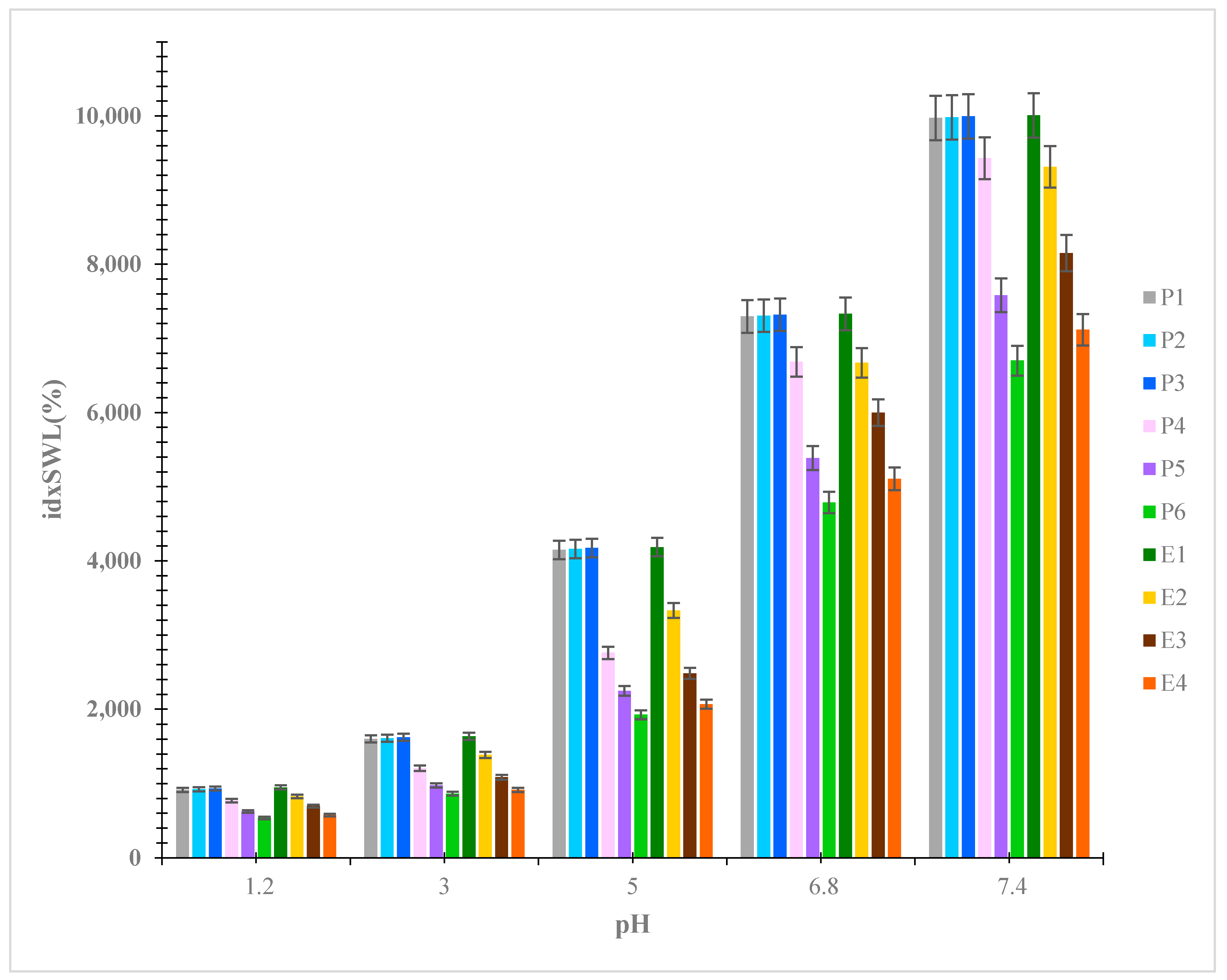
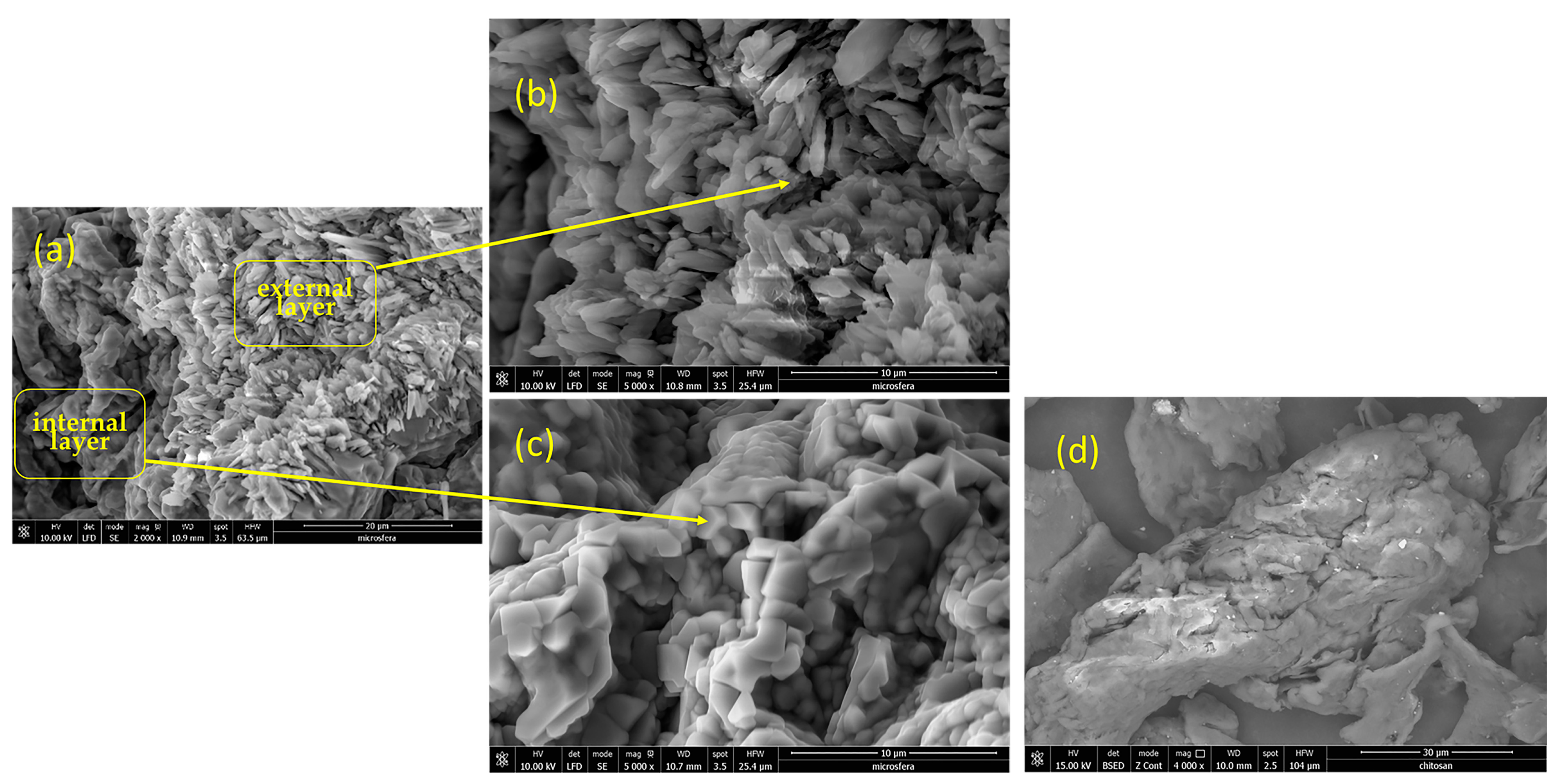
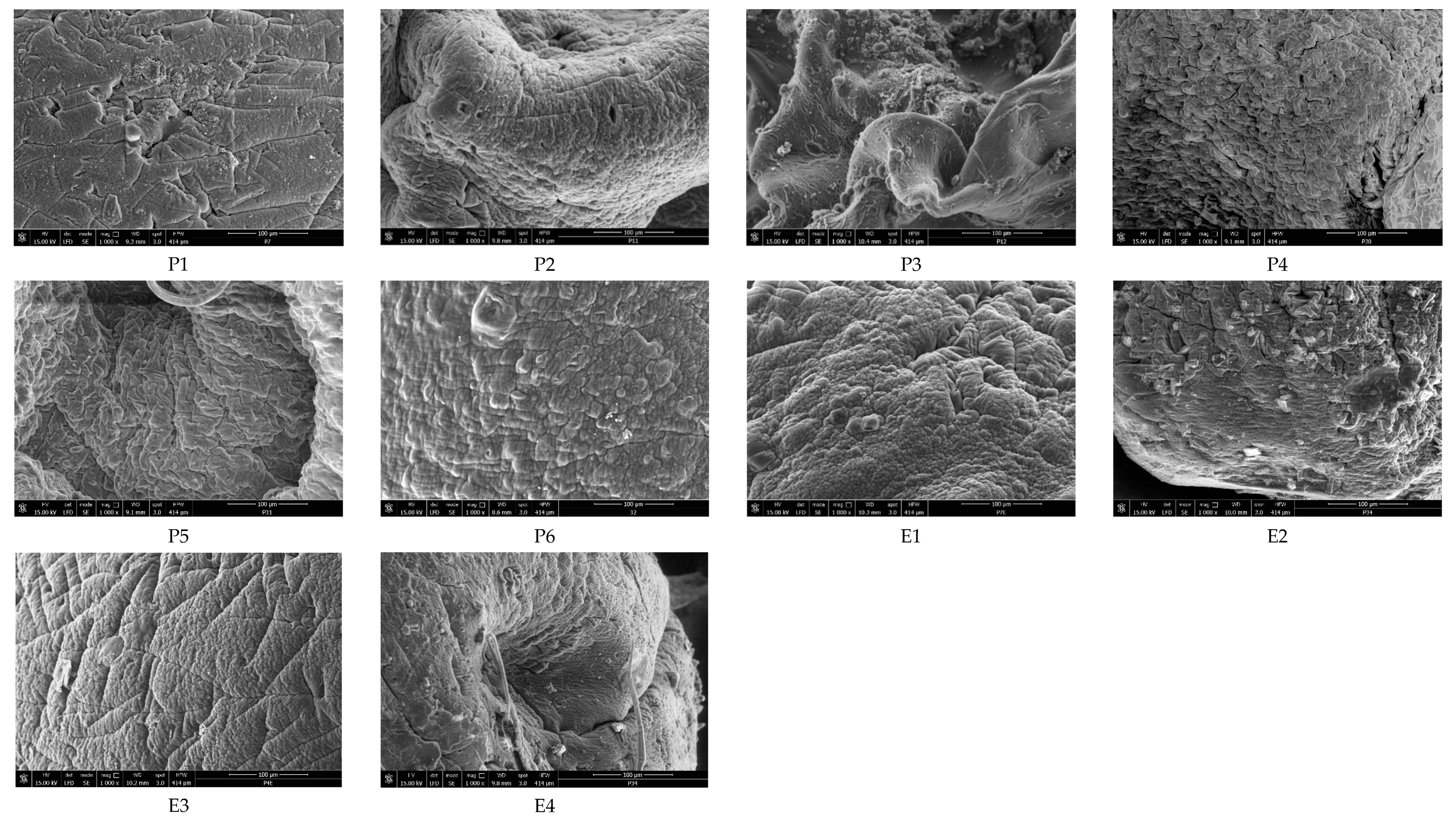
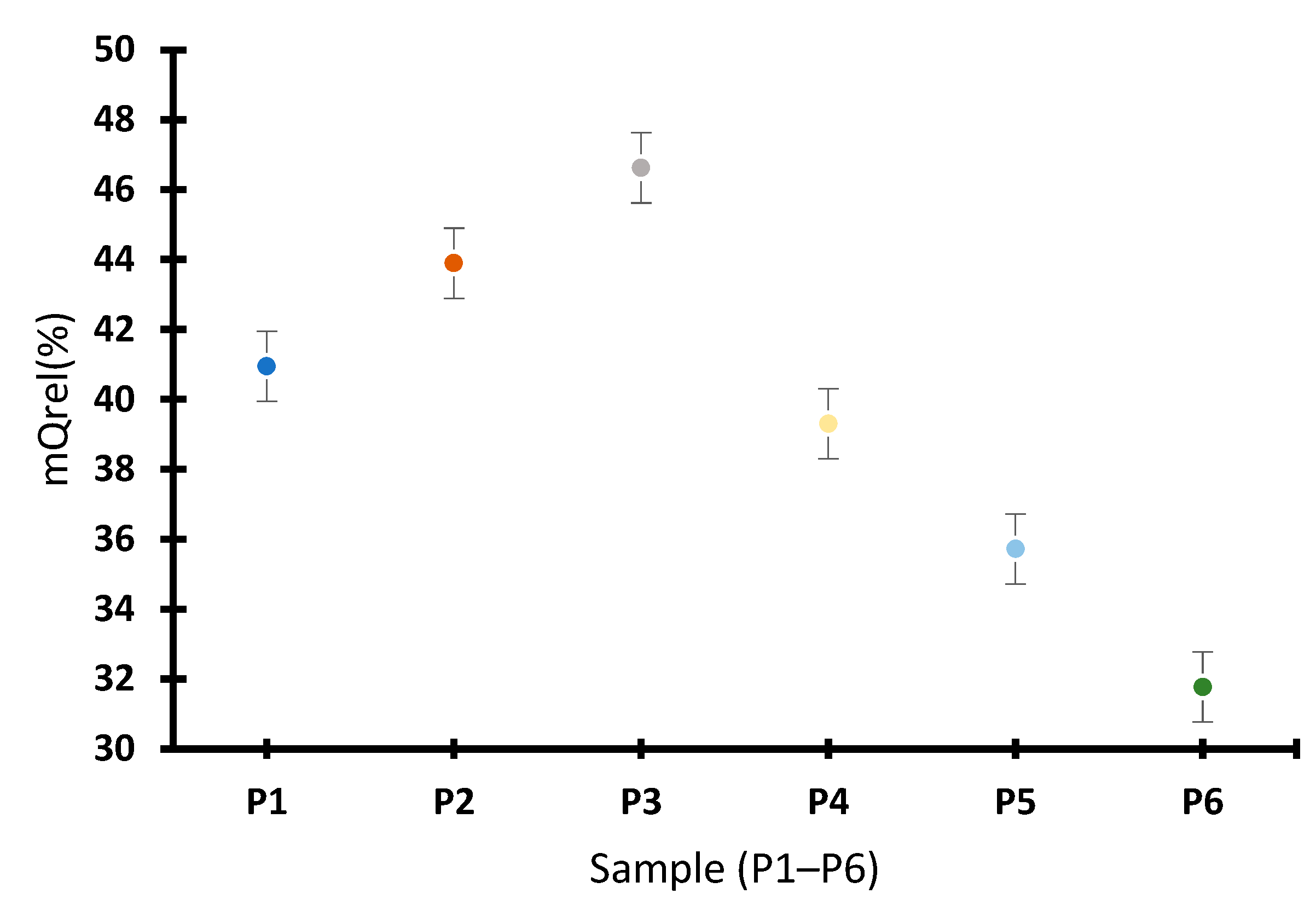

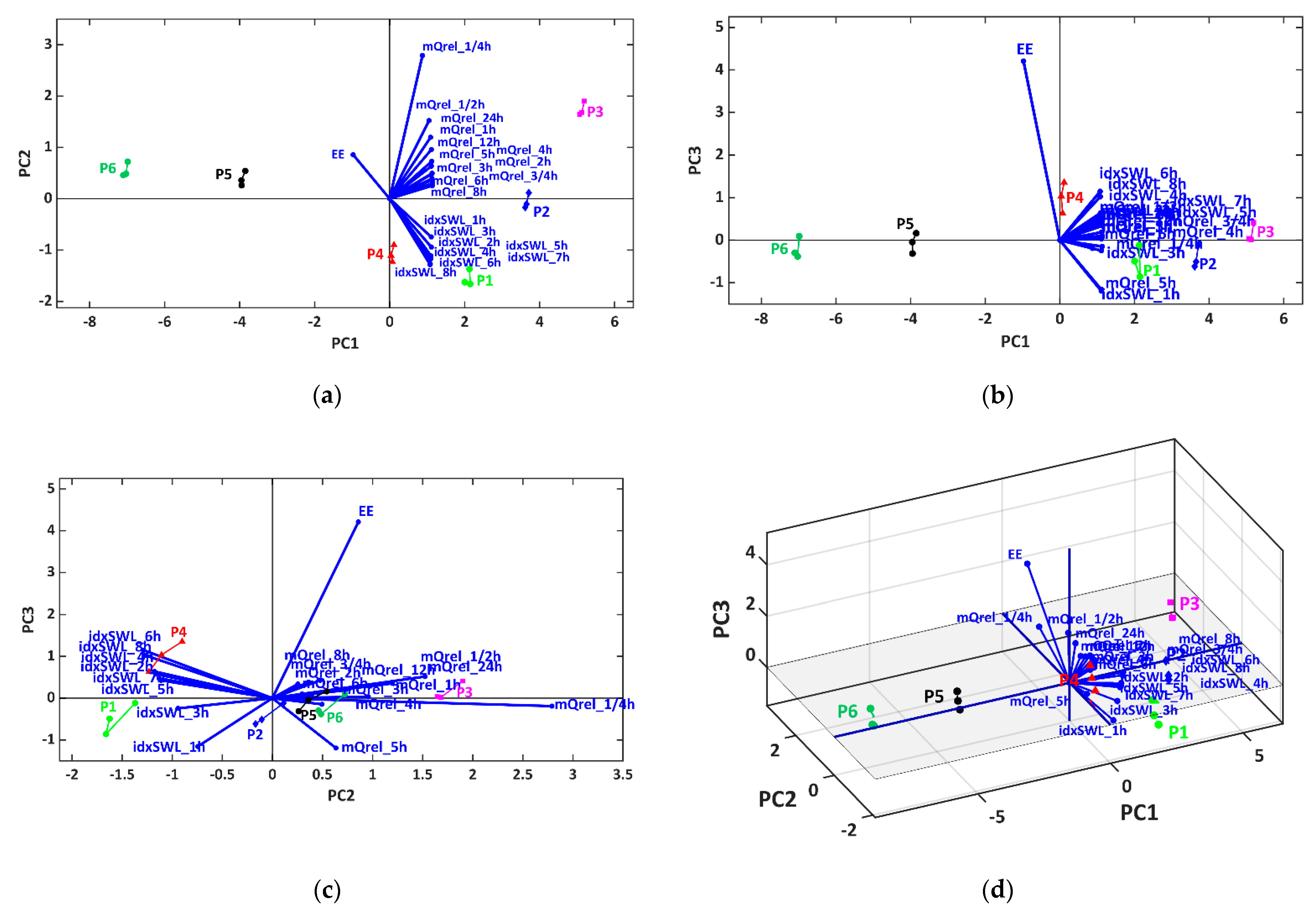

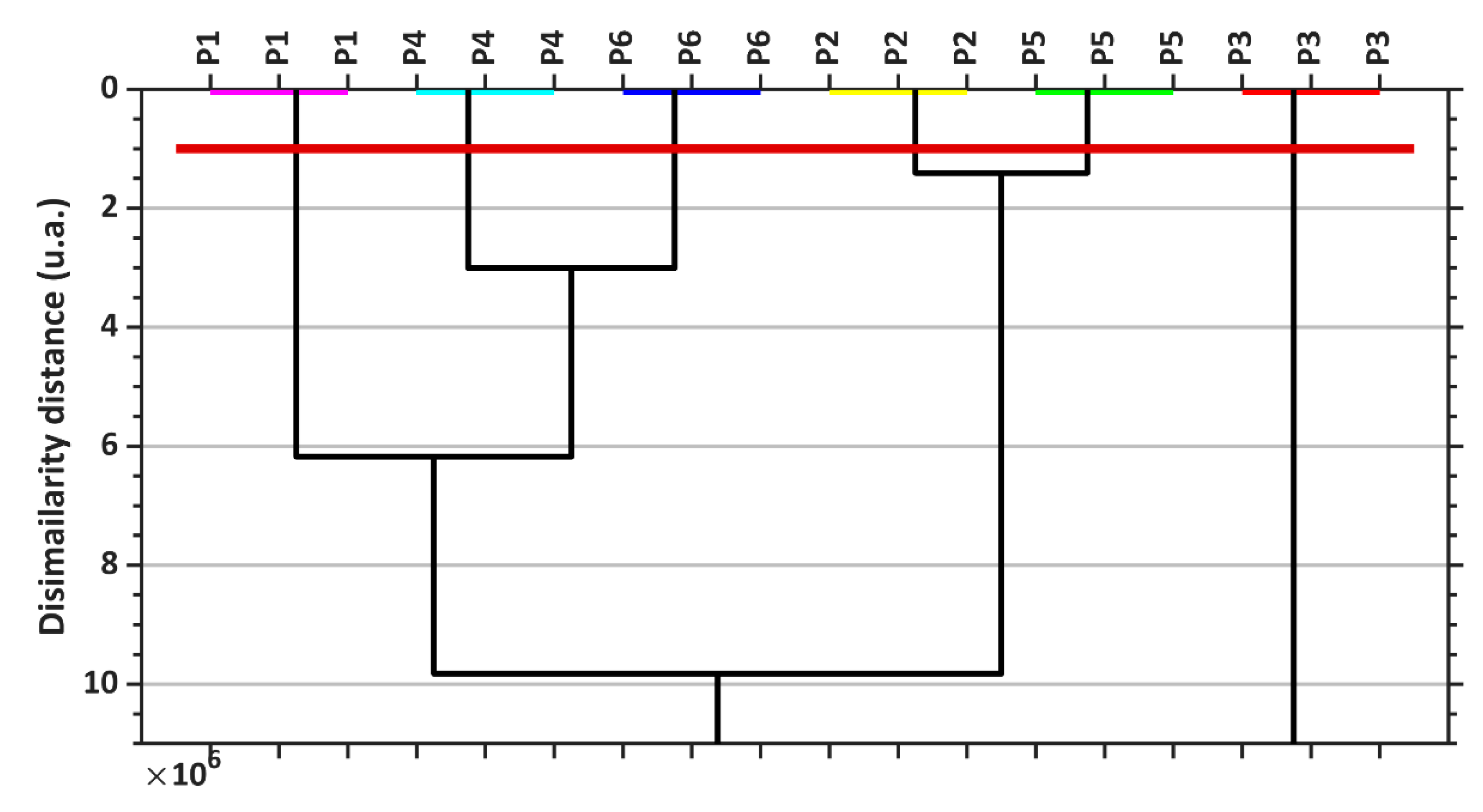

| Sample | Amount of Q (g) | Concentration of Ch (%) | Concentration of Na-Alg (%) |
|---|---|---|---|
| P1 | 0.050 | 0.4 | 0.75 |
| P2 | 0.075 | 0.4 | 0.75 |
| P3 | 0.100 | 0.4 | 0.75 |
| P4 | 0.100 | 0.1 | 2 |
| P5 | 0.100 | 0.2 | 2 |
| P6 | 0.100 | 0.4 | 2 |
| E1 | 0.4 | 0.75 | |
| E2 | 0.1 | 2 | |
| E3 | 0.2 | 2 | |
| E4 | 0.4 | 2 |
| Sample | EE(%) |
|---|---|
| P1 | 86.91 ± 1.10 |
| P2 | 87.02 ± 0.74 |
| P3 | 88.16 ± 0.61 |
| P4 | 91.35 ± 1.07 |
| P5 | 92.26 ± 0.27 |
| P6 | 93.11 ± 0.72 |
| Sample | idxSWL(%) | ||||
|---|---|---|---|---|---|
| pH 1.2 | pH 3 | pH 5 | pH 6.8 | pH 7.4 | |
| P1 | 914.81 ± 1.12 | 1603.54 ± 0.37 | 4149.65 ± 0.40 | 7296.74 ± 1.07 | 9973.05 ± 0.51 |
| P2 | 924.67 ± 0.77 | 1614.37 ± 1.08 | 4160.47 ± 0.36 | 7307.56 ± 0.65 | 9983.94 ± 0.25 |
| P3 | 935.68 ± 1.2 | 1627.04 ± 0.42 | 4173.15 ± 0.45 | 7320.24 ± 1.02 | 9996.62 ± 0.79 |
| P4 | 772.21 ± 0.8 | 1207.63 ± 1.13 | 2760.37 ± 0.64 | 6684.78 ± 0.54 | 9431.45 ± 0.82 |
| P5 | 623.97 ± 0.24 | 977.14 ± 0.20 | 2247.39 ± 0.38 | 5387.67 ± 1.15 | 7582.58 ± 0.73 |
| P6 | 537.76 ± 0.99 | 864.17 ± 1.06 | 1926.48 ± 0.43 | 4787.32 ± 0.63 | 6701.29 ± 0.39 |
| E1 | 948.77 ± 1.98 | 1639.72 ± 1.06 | 4185.83 ± 1.09 | 7332.92 ± 0.43 | 10,009.30 ± 1.11 |
| E2 | 827.34 ± 0.32 | 1388.50 ± 0.17 | 3332.77 ± 0.93 | 6671.29 ± 0.71 | 9315.42 ± 0.35 |
| E3 | 697.028 ± 0.54 | 1086.89 ± 1.22 | 2483.18 ± 0.58 | 5999.07 ± 0.33 | 8150.10 ± 0.98 |
| E4 | 576.96 ± 0.62 | 914.93 ± 0.36 | 2066.73 ± 0.45 | 5108.21 ± 0.21 | 7117.48 ± 0.77 |
| Sample | Evaluation Area (µm2) | Sa (µm) | Sq (µm) | Sp (µm) | Sv (µm) | Sz (µm) |
|---|---|---|---|---|---|---|
| P1 | 1279 × 1280 | 31.31 ± 0.12 | 70.16 ± 0.71 | 646.03 ± 0.66 | 573.40 ± 0.23 | 1219.44 ± 0.05 |
| P2 | 1279 × 1280 | 33.20 ± 0.53 | 76.54 ± 0.28 | 682.17 ± 0.45 | 668.63 ± 0.26 | 1350.81 ± 0.01 |
| P3 | 1279 × 1280 | 47.66 ± 0.47 | 112.45 ± 0.63 | 773.21 ± 0.31 | 514.03 ± 0.35 | 1287.25 ± 0.98 |
| P4 | 1279 × 1280 | 10.49 ± 0.36 | 33.78 ± 1.27 | 464.26 ± 0.15 | 532.05 ± 0.40 | 996.31 ± 1.30 |
| P5 | 1279 × 1280 | 9.95 ± 1.09 | 27.14 ± 0.04 | 311.50 ± 0.76 | 311.13 ± 0.12 | 622.63 ± 1.11 |
| P6 | 1279 × 1280 | 5.95 ± 2.07 | 16.99 ± 1.08 | 257.96 ± 0.54 | 277.26 ± 0.02 | 535.23 ± 0.46 |
| E1 | 1279 × 1280 | 32.93 ± 0.88 | 71.31 ± 0.26 | 630.69 ± 0.63 | 560.65 ± 0.69 | 1191.35 ± 0.47 |
| E2 | 1279 × 1280 | 15.24 ± 0.63 | 38.45 ± 0.18 | 313.77 ± 0.24 | 272.16 ± 0.25 | 585.93 ± 0.64 |
| E3 | 1279 × 1280 | 10.01 ± 0.21 | 29.27 ± 0.46 | 114.60 ± 0.72 | 219.23 ± 0.85 | 333.83 ± 1.07 |
| E4 | 1279 × 1280 | 6.32 ± 0.08 | 18.91 ± 0.34 | 60.80 ± 0.41 | 260.74 ± 0.11 | 321.55 ± 0.54 |
| Sample | mQrel(%) pH 7.4 | ||||||||
|---|---|---|---|---|---|---|---|---|---|
| 1 h | 2 h | 3 h | 4 h | 5 h | 6 h | 8 h | 12 h | 24 h | |
| P1 | 14.05 ± 0.61 | 29.46 ± 0.15 | 41.37 ± 1.14 | 49.10 ± 0.71 | 56.65 ± 0.61 | 62.41 ± 1.06 | 68.68 ± 0.47 | 73.71 ± 1.42 | 81.40 ± 0.57 |
| P2 | 16.71 ± 1.18 | 31.59 ± 0.71 | 42.37 ± 1.06 | 53.43 ± 0.44 | 61.65 ± 1.14 | 66.74 ± 1.01 | 71.54 ± 1.14 | 78.57 ± 0.69 | 85.41 ± 1.19 |
| P3 | 22.05 ± 1.14 | 36.26 ± 0.95 | 44.70 ± 2.14 | 57.76 ± 0.91 | 61.45 ± 0.65 | 66.91 ± 0.90 | 73.33 ± 1.07 | 81.50 ± 1.27 | 91.06 ± 0.15 |
| P4 | 12.05 ± 0.61 | 26.28 ± 0.87 | 37.86 ± 0.46 | 46.76 ± 1.14 | 55.51 ± 2.30 | 61.52 ± 0.79 | 66.83 ± 0.15 | 71.38 ± 1.20 | 80.73 ± 1.29 |
| P5 | 8.46 ± 1.61 | 22.59 ± 1.39 | 33.37 ± 0.95 | 42.76 ± 0.95 | 50.94 ± 0.84 | 57.08 ± 1.16 | 62.57 ± 1.19 | 68.04 ± 0.27 | 76.87 ± 0.38 |
| P6 | 5.05 ± 0.18 | 16.51 ± 0.57 | 28.48 ± 1.15 | 36.39 ± 0.47 | 46.94 ± 0.88 | 51.53 ± 0.31 | 57.60 ± 0.37 | 63.92 ± 1.28 | 71.46 ± 0.25 |
| Microorganisms | Inhibition Zone in Diameter (mm) | |||||||||
|---|---|---|---|---|---|---|---|---|---|---|
| SQ0.1 | SNa-Alg0.75 | SNa-Alg2 | SCh0.1 | SCh0.2 | SCh0.4 | SP3 | SP4 | SP5 | SP6 | |
| Staphylococcus aureus ATCC 25923 | NI | NI | NI | 12 ± 0.1 | 12.5 ± 1.2 | 12.8 ± 0.4 | 13.5 ± 0.7 | 12.4 ± 0.3 | 12.7 ± 0.7 | 13.6 ± 0.9 |
| Pseudomonas aeruginosa ATCC 27853 | NI | NI | NI | 11 ± 0.2 | 11.2 ± 0.5 | 11.5 ± 2.7 | 13.9 ± 0.1 | 13.1 ± 0.6 | 13.5 ± 0.1 | 14 ± 0.4 |
| Escherichia coli ATCC 25922 | NI | NI | NI | 11.7 ± 0.1 | 12.3 ± 0.8 | 12.4 ± 0.5 | 15.3 ± 0.3 | 14.4 ± 0.7 | 14.9 ± 0.5 | 15.2 ± 0.3 |
| Candida albicans ATCC 90028 | NI | NI | NI | 11.3 ± 0.2 | 11.9 ± 0.6 | 12.1 ± 0.4 | 14.2 ± 0.7 | 13.3 ± 0.3 | 13.9 ± 0.2 | 14.2 ± 0.8 |
| Clinical Isolates Strain | Inhibition Zone in Diameter (mm) | |||||||||
|---|---|---|---|---|---|---|---|---|---|---|
| SQ0.1 | SNa-Alg0.75 | SNa-Alg2 | SCh0.1 | SCh0.2 | SCh0.4 | SP3 | SP4 | SP5 | SP6 | |
| Staphylococcus aureus | NI | NI | NI | 12.2 ± 0.1 | 12.6 ± 0.2 | 12.9 ± 0.1 | 13.9 ± 0.6 | 12.9 ± 0.3 | 13.4 ± 0.1 | 13.8 ± 0.3 |
| Streptococcus pyogenes | NI | NI | NI | 11 ± 0.2 | 11.7 ± 0.6 | 12.3 ± 0.7 | 12.2 ± 0.4 | 12.3 ± 0.7 | 12.3 ± 0.6 | 12.2 ± 0.2 |
| Klebsiella pneumoniae SSP | NI | NI | NI | 11 ± 0.2 | 11.8 ± 0.5 | 12.3 ± 0.8 | 12.4 ± 0.9 | 12.3 ± 0.6 | 12.3 ± 0.1 | 12.4 ± 0.8 |
| Microorganisms | Inhibition Zone in Diameter (mm) | ||||||
|---|---|---|---|---|---|---|---|
| Penicillin | Vancomycin | Ofloxacin | Meropenem | Fluconazole | Cephalexin | Distillated Water | |
| Staphylococcus aureus ATCC 25923 | 30 ± 0.8 | 18 ± 0.6 | 27 ± 0.8 | 30 ± 0.8 | Not tested | Not tested | 6 |
| Pseudomonas aeruginosa ATCC 27853 | Not tested | Not tested | 19 ± 0.6 | 28 ± 0.8 | Not tested | Not tested | 6 |
| Escherichia coli ATCC 25922 | Not tested | Not tested | 30 ± 0.8 | 29 ± 0.8 | Not tested | Not tested | 6 |
| Candida albicans ATCC 90028 | Not tested | Not tested | Not tested | Not tested | 32 ± 1.2 | Not tested | 6 |
| Streptococcus pyogenes | 32 ± 0.7 | 22 ± 0.6 | 19 ± 0.6 | Not tested | Not tested | Not tested | 6 |
| Staphylococcus aureus | 22 ± 0.6 | Not tested | 24 ± 0.7 | Not tested | Not tested | Not tested | 6 |
| Klebsiella pneumoniae SSP | Not tested | Not tested | Not tested | Not tested | Not tested | 28 ± 0.9 | 6 |
| MANOVA, p-Values | P1 | P2 | P3 | P4 | P5 | P6 |
|---|---|---|---|---|---|---|
| P1 | 1 | <0.0001 | <0.0001 | <0.0001 | <0.0001 | <0.0001 |
| P2 | <0.0001 | 1 | <0.0001 | <0.0001 | <0.0001 | <0.0001 |
| P3 | <0.0001 | <0.0001 | 1 | <0.0001 | <0.0001 | <0.0001 |
| P4 | <0.0001 | <0.0001 | <0.0001 | 1 | <0.0001 | <0.0001 |
| P5 | <0.0001 | <0.0001 | <0.0001 | <0.0001 | 1 | <0.0001 |
| P6 | <0.0001 | <0.0001 | <0.0001 | <0.0001 | <0.0001 | 1 |
| Cluster_1 | Cluster_2 | Cluster_3 | Cluster_4 | Cluster_5 | Cluster_6 |
|---|---|---|---|---|---|
| P2 | P5 | P4 | P6 | P1 | P3 |
| P2 | P5 | P4 | P6 | P1 | P3 |
| P2 | P5 | P4 | P6 | P1 | P3 |
Disclaimer/Publisher’s Note: The statements, opinions and data contained in all publications are solely those of the individual author(s) and contributor(s) and not of MDPI and/or the editor(s). MDPI and/or the editor(s) disclaim responsibility for any injury to people or property resulting from any ideas, methods, instructions or products referred to in the content. |
© 2023 by the authors. Licensee MDPI, Basel, Switzerland. This article is an open access article distributed under the terms and conditions of the Creative Commons Attribution (CC BY) license (https://creativecommons.org/licenses/by/4.0/).
Share and Cite
Frent, O.-D.; Duda-Seiman, D.M.; Vicas, L.G.; Duteanu, N.; Nemes, N.S.; Pascu, B.; Teusdea, A.; Morgovan, C.M.; Muresan, M.E.; Jurca, T.; et al. Study of the Influence of the Excipients Used for the Synthesis of Microspheres Loaded with Quercetin: Their Characterization and Antimicrobial Activity. Coatings 2023, 13, 1376. https://doi.org/10.3390/coatings13081376
Frent O-D, Duda-Seiman DM, Vicas LG, Duteanu N, Nemes NS, Pascu B, Teusdea A, Morgovan CM, Muresan ME, Jurca T, et al. Study of the Influence of the Excipients Used for the Synthesis of Microspheres Loaded with Quercetin: Their Characterization and Antimicrobial Activity. Coatings. 2023; 13(8):1376. https://doi.org/10.3390/coatings13081376
Chicago/Turabian StyleFrent, Olimpia-Daniela, Daniel Marius Duda-Seiman, Laura Gratiela Vicas, Narcis Duteanu, Nicoleta Sorina Nemes, Bogdan Pascu, Alin Teusdea, Claudia Mona Morgovan, Mariana Eugenia Muresan, Tunde Jurca, and et al. 2023. "Study of the Influence of the Excipients Used for the Synthesis of Microspheres Loaded with Quercetin: Their Characterization and Antimicrobial Activity" Coatings 13, no. 8: 1376. https://doi.org/10.3390/coatings13081376
APA StyleFrent, O.-D., Duda-Seiman, D. M., Vicas, L. G., Duteanu, N., Nemes, N. S., Pascu, B., Teusdea, A., Morgovan, C. M., Muresan, M. E., Jurca, T., Pallag, A., Micle, O., & Marian, E. (2023). Study of the Influence of the Excipients Used for the Synthesis of Microspheres Loaded with Quercetin: Their Characterization and Antimicrobial Activity. Coatings, 13(8), 1376. https://doi.org/10.3390/coatings13081376









